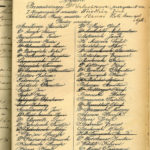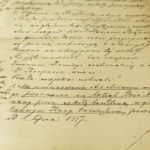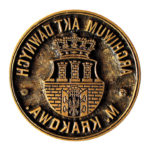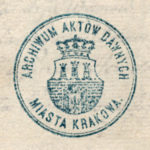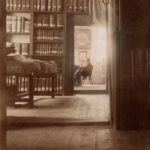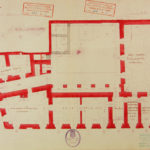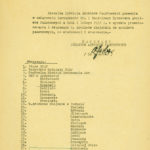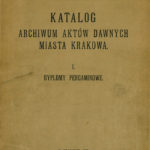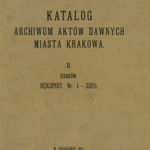Guarding history. Krakow Town Archives of Former Records 1887–1952 - Archive
„Historical records in skilful hands…”
The rich collections of municipal documentation, gathered since the Old-Polish times and spread among many places and offices, represented a subject of interest in the second half of the 19th century for the authorities in Krakow and the scientific environment concentrated around the Academy of Learning and Jagiellonian University. These collections were popularised among the residents of the town by the researcher of national “ancient history”, the bookseller Ambroży Grabowski (1782–1868). After Galicja had obtained autonomy, a special department was established, and later an Archival Committee, to regulate the documentation of municipal matters, and the position of permanent archivist to take care of former municipal records was created at the Town Hall. In 1871, this role was taken by Teofil Żebrawski, and later, in 1887, by Franciszek Piekosiński. Suitable conditions for the development of municipal archives were obtained thanks to the granting of space in the town-house at 16 Sienna Street with the resolution of the Town Council from 2 June 1887. This date is traditionally taken as the start of the Krakow Town Archives of Former Records. Town Archives of Former Records initially occupied only part of the space and the whole town-house was taken over in perpetuity in 1906. The Society of Lovers of Krakow’s History and Monuments was established inside its friendly walls and operated there for many years, whereas one branch of the Archives collecting municipal souvenirs, located from 1909 on the ground floor of the town-house, was the beginning of the current Historical Museum of the City of Krakow.
„Archives should be safe for the rights of all citizens and towns”
From the establishment of the new unit, work to categorise the collections was carried out systematically. The effect of this work was two volumes of the Katalogu Archiwum Aktów Dawnych Miasta Krakowa (Catalogue of the Krakow Town Archives of Former Records), which were published by the director Stanisław Krzyżanowski. These concerned parchment documents and Krakow’s municipal records from the Old-Polish period. Indexes and catalogues were prepared, and attention was also given to the protection and conservation of the resources. The Archives also became a significant place for research work. Its rank as a scientific institution was highlighted by publications in the series “Publications of the Krakow Town Archives of Former Records.” The archival collections in Krakow survived the period of World War II and the German occupation without almost any damage. Due to the approaching front in 1944, Marian Friedberg, director of the town archives, and Włodzimierz Budka, from the State Archives, convinced the chief of archives of the General Government – Erich Randt, to not move the collections to the Johannesberg Castle in the Sudety Mountains, but to safeguard them in the abbey in Tyniec. The collections returned from there to the archival storerooms after the War. The post-war reorganisation of public administration also changed the working principles of the Krakow archives. In 1951, the Krakow Town Archives of Former Records became subordinate to the Supervisory Director of the State Archives in Warsaw, and on 1 February 1952 it was merged with the State Archives in Krakow. That is how the Regional State Archives in Krakow was established. From 1984, it operated as the State Archives in Krakow, which in 2012 was renamed as the National Archives in Krakow



